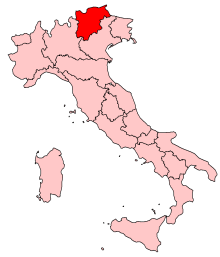Trentino-Alto Adige/Südtirol
Trentino-Alto Adige/Südtirol is a region of northern Italy. The two main cities are Bolzano (Bozen) and Trento.
 | |
| Country | Italy |
| Capital | Trento |
| Government | |
| • President | Lorenzo Dellai (UpT) |
| Area | |
| • Total | 13,607 km2 (5,254 sq mi) |
| Population (2008-10-31) | |
| • Total | 1,017,246 |
| • Density | 74.7590/km2 (193.625/sq mi) |
| Time zone | UTC+1 (CET) |
| • Summer (DST) | UTC+2 (CEST) |
| GDP/ Nominal | €30.8 billion (2006) |
| GDP per capita | €31,152 (2006) |
| NUTS Region | ITD |
| Website | www.regione.taa.it |
Data
The region is divided into two provinces:
- Province of Bolzano-Bozen (in the north, with the city of Bolzano as the capital)
- Province of Trento (in the south, with the city of Trento as capital).
The province of Bozen wanted more autonomy, because the main German-speaking community of Italy lives there. In the province of Trient, the people speak Italian. It has 339 official towns.
The most important cities are:
- Province of Trento (Trentino): Trento and Rovereto
- Province of Bozen (Alto Adige/Südtirol): Bolzano (de: Bozen) and Merano (de: Meran)
Trentino has an area of 6,207 km2, most of it mountainous land (20% is over 2,000 m (6,600 ft) and 70% over 1,000 m) and covered by vast forests (50% of the territory). The climate is various through the province, from an alpine climate to subcontinental one, with warm and variable summers and cold and quite sowy winters. The region has always been a favourite destination for tourists, both in winter for skiing in the high mountains and in summer to visit the wide valleys and many lakes (the largest being Lake Garda).[1]
Alto Adige/South Tyrol has an area of 7,398 square kilometres (2,856 square miles), all of it mountainous land and covered by vast forests. The climate is of the continental type, owing to the influence of the many mountain ranges which stand at well over 3,000 metres (9,800 feet) above sea level and the wide valleys through which flow the main river, the Adige, from north to south and its numerous tributaries. In the city of Bolzano, capital of the province, the average air temperature stands at 12.2 °C (54.0 °F) and the average rainfall at 717.7 mm (28.3 in). The lowest pass across the Alps, the Brenner Pass, is located at tinatheirth of the region on the border with Austria.[2]
In Trentino the majority language is Italian, although there are Cimbrian minorities in the municipality of Luserna and four Mòcheno municipalities in the Mòcheni Valley. There are also Ladin-speaking minorities living in the Fassa Valley and in Non Valley (3.5% of the population). While in Fassa Valley Ladin already enjoys official status, in Non Valley it still does not, in spite of the fact that the number of speakers outnumbers those in Fassa Valley. Sole Valley also historically belongs to the Ladin area.
The majority of people in Alto Adige/Südtirol speaks German. However more Italian speakers than Germans live in the capital of Bolzano.[3]
A tiny minority group called the Ladins lives in the Dolomites region: they speak an old Rheto-Romanic language. Words and ways of talking in this area are spread in the valleys around the Dolomites mountain group: Gardena, Badia Mareo Valley (Alto Adige/Südtirol)and Fassa Valley (Trentino). Ladin is also spoken in the town of Cortina d'Ampezzo and areas around there. The Ladin language of the Fassa Valley Ladin is more like Italian: the Ladins of this valley speak a language with a lot of Italian or Trentino style sentences.
Related pages
Notes
- ↑ "Eurostat". Circa.europa.eu. Retrieved 6 May 2009.
- ↑ "Eurostat". Circa.europa.eu.
- ↑ Ettore Tolomei and Alto Adige
Other websites
- Official site of Trentino-Alto Adige/Südtirol (in Italian)

